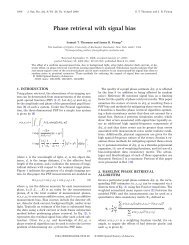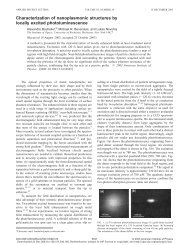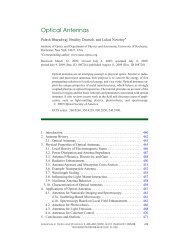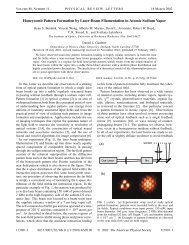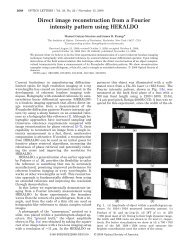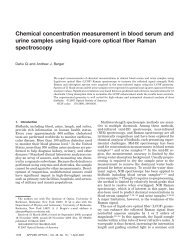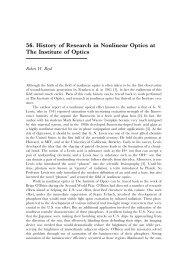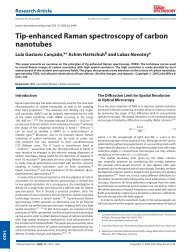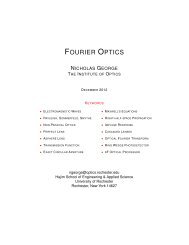Nonlinear Excitation of Surface Plasmon Polaritons by Four-Wave ...
Nonlinear Excitation of Surface Plasmon Polaritons by Four-Wave ...
Nonlinear Excitation of Surface Plasmon Polaritons by Four-Wave ...
Create successful ePaper yourself
Turn your PDF publications into a flip-book with our unique Google optimized e-Paper software.
PRL 101, 056802 (2008)<br />
PHYSICAL REVIEW LETTERS week ending<br />
1 AUGUST 2008<br />
defined <strong>by</strong> the diameter <strong>of</strong> the incident laser beams relative<br />
to the size <strong>of</strong> the back aperture (13 mm) <strong>of</strong> the objective<br />
lens. The angle <strong>of</strong> emission is measured <strong>by</strong> projecting the<br />
scattered beam at ! 4wm on a thermoelectrically cooled<br />
CCD. Thus, the displacement x <strong>of</strong> the detected spot on<br />
the CCD measured from the optical axis is a direct measure<br />
for the transverse wave vector k x k=f x [14], with f<br />
being the focal length <strong>of</strong> the objective and k n! 4wm =c<br />
being the wave vector <strong>of</strong> the emitted radiation.<br />
The third-order susceptibility 3 giving rise to fourwave<br />
mixing is a tensor <strong>of</strong> rank 3. Although the symmetry<br />
<strong>of</strong> our experimental configuration allows many components<br />
<strong>of</strong> the tensor to be eliminated, the number <strong>of</strong> unknowns<br />
remains high. Furthermore, in addition to the bulk<br />
response, we have to take into consideration the surfacespecific<br />
response. Therefore, to establish an understanding<br />
for the observed third-order response, we relate our observations<br />
to SHG, which is a reasonably well understood<br />
second-order process [10–12]. In fact, for SHG the bulk<br />
response can be greatly ignored, and only two tensor<br />
components <strong>of</strong> the surface susceptibility need to be<br />
considered [10].<br />
Thus, let us first consider SHG <strong>by</strong> two collinear excitation<br />
beams incident at the angle as shown in Fig. 2(a).<br />
The two beams are p-polarized and are incident from glass<br />
d<br />
ε 3<br />
ε 2<br />
ε 1<br />
P<br />
where all quantities are evaluated at the second-harmonic<br />
frequency 2!. The coupling to the surface plasmons propagating<br />
at the top interface is dominated <strong>by</strong> the poles <strong>of</strong> the<br />
r 23 term, i.e., k 2z " 3 k 3z " 2 0. Efficient coupling to<br />
surface plasmons results in strong leakage radiation [18].<br />
However, the latter interferes with the nonlinear field emitted<br />
from the lower interface. This interference is repreθ<br />
P<br />
z<br />
θ<br />
θ<br />
ω<br />
2ω<br />
2ω<br />
FIG. 2 (color online). Illustration <strong>of</strong> nonlinear surface plasmon<br />
excitation <strong>by</strong> SHG. (a) The incident laser field generates nonlinear<br />
surface polarizations at the lower and upper gold interfaces.<br />
(b) The nonlinear polarization P # at the lower interface<br />
acts as a source for a secondary field at the nonlinear frequency<br />
2!. (c) The same holds for the polarization P " at the upper<br />
interface.<br />
(a)<br />
(b)<br />
(c)<br />
2<br />
S<br />
x<br />
x<br />
x<br />
2<br />
S;xzx<br />
(" 1 2:25) onto a gold film <strong>of</strong> thickness d and dielectric<br />
function " 2 ! . It has been demonstrated that the largest<br />
contribution to the nonlinear signal at frequency 2! originates<br />
from a second-order surface susceptibility<br />
[10,15], where the indices indicate field components parallel<br />
(x) and perpendicular (z) to the interface, respectively.<br />
The incident waves are represented as<br />
E ! E 0 k 1z =k 1 n x k x =k 1 n z e ik xx ik 1z z i!t ; (1)<br />
where k 1 k x ; 0;k 1z and k 2 1 " 1 !=c 2 . n x and n z are<br />
unit vectors in the x and z directions, respectively. The<br />
components <strong>of</strong> the k 1 vector are determined <strong>by</strong> the angle <strong>of</strong><br />
incidence according to k x k 1 cos and k 1z k 1 sin .<br />
As illustrated in Figs. 2(b) and 2(c), we consider two interfaces.<br />
The surface polarization at the second-harmonic<br />
frequency on the bottom interface is calculated as<br />
P # x 2! " o<br />
2<br />
S;xzx 2!; !; ! E z ! E x !<br />
2 "<br />
" 1<br />
o S;xzx E2 0<br />
1<br />
" 2<br />
1<br />
r 12 r 23 exp 2ik 2z d<br />
1 r 12 r 23 exp 2ik 2z d<br />
r 12 r 23 exp 2ik 2z d<br />
1 r 12 r 23 exp 2ik 2z d<br />
k x k 1z<br />
k 2 e 2ik xx 2i!t ; (2)<br />
1<br />
where we have used the single-interface Fresnel reflection<br />
and transmission coefficients for p polarization [16].<br />
Notice that both exciting fields (E z and E x ) are evaluated<br />
on the gold side <strong>of</strong> the interface and that all<br />
q<br />
quantities are<br />
evaluated at the frequency !. Also, k 2z k 2 2 k 2 x.<br />
The polarization P # x now acts as a source current at the<br />
second-harmonic frequency, and the resulting field E 2!<br />
is calculated as<br />
E r; 2!<br />
2!=c 2<br />
" o<br />
Zsurface<br />
G $ r; r 0 ;2! P # r 0 ; 2! dr 0 :<br />
(3)<br />
The field radiated into the upper space is reflected from the<br />
top boundary and then superimposed to the field emitted<br />
into the lower space. The total field in the lower half-space<br />
due to the polarization P # x is then calculated to be [17]<br />
E # 2!<br />
P # x k 1 k 2 r 23 t 21 exp 2ik 2z d<br />
2" o " 1 " 2 1 r 12 r 23 exp 2ik 2z d<br />
k 1z =k 1 n x 2 k x =k 1 n z e ik 1zz ; (4)<br />
056802-2



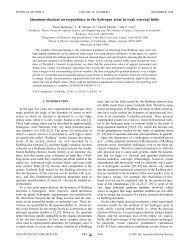
![Phase retrieval algorithms: a personal tour [Invited] - The Institute of ...](https://img.yumpu.com/25023725/1/190x249/phase-retrieval-algorithms-a-personal-tour-invited-the-institute-of-.jpg?quality=85)
